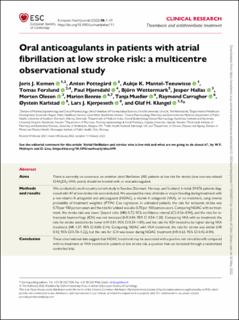| dc.description.abstract | Aims There is currently no consensus on whether atrial fibrillation (AF) patients at low risk for stroke (one non-sex-related CHA2DS2-VASc point) should be treated with an oral anticoagulant. Methods and results We conducted a multi-country cohort study in Sweden, Denmark, Norway, and Scotland. In total, 59 076 patients diagnosed with AF at low stroke risk were included. We assessed the rates of stroke or major bleeding during treatment with a non-vitamin K antagonist oral anticoagulant (NOAC), a vitamin K antagonist (VKA), or no treatment, using inverse probability of treatment weighted (IPTW) Cox regression. In untreated patients, the rate for ischaemic stroke was 0.70 per 100 person-years and the rate for a bleed was also 0.70 per 100 person-years. Comparing NOAC with no treatment, the stroke rate was lower [hazard ratio (HR) 0.72; 95% confidence interval (CI) 0.56–0.94], and the rate for intracranial haemorrhage (ICH) was not increased (HR 0.84; 95% CI 0.54–1.30). Comparing VKA with no treatment, the rate for stroke tended to be lower (HR 0.81; 95% CI 0.59–1.09), and the rate for ICH tended to be higher during VKA treatment (HR 1.37; 95% CI 0.88–2.14). Comparing NOAC with VKA treatment, the rate for stroke was similar (HR 0.92; 95% CI 0.70–1.22), but the rate for ICH was lower during NOAC treatment (HR 0.63; 95% CI 0.42–0.94). Conclusion These observational data suggest that NOAC treatment may be associated with a positive net clinical benefit compared with no treatment or VKA treatment in patients at low stroke risk, a question that can be tested through a randomized controlled trial. Key question What is the association between anticoagulant treatment and stroke and bleeding rate, in patients with one non-sex-related risk factor for stroke? Key findings Non-vitamin K antagonist oral anticoagulant (NOAC) treatment was associated with a lower stroke rate compared with no treatment. Non-vitamin K antagonist oral anticoagulant treatment was associated with a lower rate of intracranial haemorrhage compared with vitamin K antagonist (VKA) treatment. Take-home message These observational data suggest that NOAC treatment may be associated with a positive net clinical benefit compared with no treatment or VKA treatment in patients at low stroke risk, a hypothesis that can be tested through a randomized controlled trial. | |
